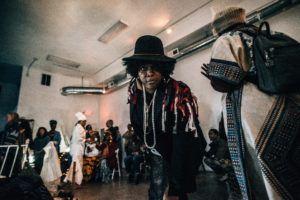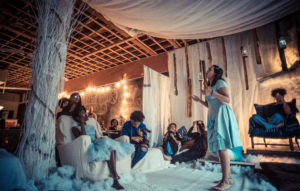
Pictured: Yvette Phillips Aldama
[Image description: Black and white image of a woman in a white room dressed in white laying on a white couch and appears to be asleep. Her arms are crossed and her head is propped on fabric as a pillow.]
House/Full of BlackWomen has been built in episodes over a five-year period, sustaining a question posed by Ellen Sebastian Chang and Amara Tabor Smith: “How can we as Black women and girls find a space to breathe and be well within a stable home?” While I had known Ellen since the late 1980s and Amara for a decade, I met their shared project – as I am often introduced to projects – in a grant proposal. It was described as a site-specific ritual performance examining issues of displacement, well-being, and sex trafficking of Black women and girls in Oakland.
I’m always interested in artists tackling difficulty and defying categories, and House/Full certainly did that. It wasn’t going to be a single event but sustained over a long time. It wasn’t going to be a piece for a repertoire: likely its sections would be shared once. It wasn’t going to be distinctly contemporary or traditional in form. It wasn’t driven by a single arts organization but porous to contributions by Chapter 510 Ink; Eastside Arts Alliance; Regina’s Door (a boutique dedicated to protecting women from trafficking); and others. It was going to encompass ritual, faith, dance, theater, procession, film, and even sleeping. One artist was not “the lead” – Ellen and Amara described one another as “my art wife.”

Pictured: Nkeiruka Oruche
[Image description: A performer in all black with fabric adorning their shoulders leans down to stare directly into the camera. Other performers and audience members appear in the background and sides, out of focus.]
The piece dissolved boundaries between indoors and outdoors, performance and ceremony, between the ordinary and the transcendent; and it combined those who were initiated in a spiritual practice and those who were not. Participants moved in and out of the piece, following a singular and communal path to healing.
Can I admit how much this work challenges and compels me? I have seen two of the episodes live and viewed excerpts of others through documentation. In my memories of sections and excerpts, I feel as if I have dreamed them. I’ve also taken notes. I heard what I heard. My memories, my hearing may be in error. I will tell you about a few episodes.
I
I struggle to fold a spiritual dimension into my daily life. The religious observances of my childhood were not overtly about “the spiritual.” They were composed of Protestant church-going and occasional pot-lucks. For two years, we lived in a small town in Massachusetts, if we didn’t go to church, neighbors would turn up at the door with casseroles, assuming we were too ill to get out of bed. My father was impatient with “church people.” He saw them as gossips and hypocrites. When we moved to Southern California, we attended a church with large windows that was perched on a cliff overlooking the ocean. He tolerated religion then because there was a view.
Surrounding the church were flagstone paths one of which arched into a bridge over a koi pond. It was treacherous when wet, especially if one was running in new, slick-bottomed Mary Janes.
I was once that girl. And now, this is what I’m viewing:
Women dressed and veiled in white carry white parasols and white lanterns, walking down a street in Oakland. Many have round mirrors, framed in white fabric, and sewn over their bellies. The clothing is not identical, but its laciness, its somber affect is. I refrain from using the word “costume,” because what they are wearing seems to be more about revealing themselves than about obscuring themselves. While processing, the women are quietly singing something akin to “A wick, wick, wick; a wick, wick, wick,” a song about breathing. Sometimes there is a whispered lash-like sound. The streetscape is loud. At times the women wearing white are in the roadway and then they move along the sidewalk. They pass a white limousine and a restaurant whose annoyed hostess stands outside. They pause alongside a police car and I’m shaken in fear for them.

Left to right: Anisah Abdullah, Regina Evans, Aissaade Negus, Erica Wilson
[Image description: a performer arches back, chest raised to the ceiling. Another performer sits upstage with a third performer’s head resting on their knee. Two more performers are on either side of the stage, one standing and one seated. The stage is surrounded by pieces of wood, stools, creating a barrier. Artwork hangs on the walls behind.]
II
When I first met Ellen Sebastian, she was co-founder and artistic director of Life on the Water. She had written and directed, Your Place is No Longer with Us, which took place in a Victorian mansion. The audience moved through the house for the performance and, at the end, she served them black-eyed peas, cornbread, and mustard greens. Later, Amara Tabor-Smith served the CounterPulse audience vegan cornbread and gumbo at performances of Our Daily Bread. They had in common these histories of performing acts of caring, breaking out of “the theatrical,” expressing heritage through food and in distinctive spaces.
House/Full of BlackWomen has moved inside and out of spaces that were transformed to be more than sets or frames. Most vivid to me – perhaps because it is the episode that the Creative Work Fund partially supported – were the spaces for sleeping and dreaming at Chapter 510 Ink in Oakland.
An installation in a storefront window for resting. A rocking chair. Women position themselves. Some recline. Some watch over others. The aesthetic is tenderness. A hallway is lined with cotton. It’s hard not to touch the fragility, the suggestion of the sky and clouds and dreaming.
Chapter 510 Ink is a writing center for youth, and young women read pieces they have written about selves and fear and comfort. I remember thinking they were brave — revealing. Later I wondered about the symbolism of the cotton balls.
This 2017 episode of House/Full of BlackWomen, “Black Women Dreaming,” wasn’t the first section. It was informed, in part, by one of the work’s most radical strategies, creating a time and place for Black women to rest, recognizing the likelihood that they are juggling multiple jobs and raising children and healing others. Black women could sign up to sleep for between two and ten hours at a West Oakland boarding house, where they would be met with beverages and food as well as comfortable resting places. One-hundred and eighty women chose to sleep and dream for the project.
Later at a grantmaking conference, Amara and Ellen asked a room full of funders why “being well rested” wasn’t acceptable as a measurable outcome.
III
In grants we grab onto words and overuse them for three years or longer until they lose their power and then we grab onto new words. Two words that I believe we are about to release are engagement and immersive. How, then, do I find the right words for House/Full’s capacity to transform me into more than a witness? It happens here:
The dance is in her shoulders. She is leaning back. Her angel-open face to the sky. Draped in white. The dancer places her hand on the shoulder of a seated performer as if to comfort her, as if to tell her “It’s time.”
She bends over backwards and rises like a loping bird.
I try to identify the bird being portrayed and read, “Drag is higher in rotational motion of the wings.” That’s in contrast, an ornithologist writes, to gliding.
The dancer claims slow, rotational motion. When she crouches, her hand is jiggling. An invitation and a warning. Then her body buckles as if she is trying to eject something.
Another dancer on the floor in blue.
The third dancer is shaking in her shoulders and her whole being falls backwards. The movement quickens. The women sitting against the wall cry, laugh, yelp. Then singing:
“Black crow/black crow/please hear my cry
Black crow/black crow/I’m calling for you.”
IV
We’re in the alley behind the Eastside Arts Alliance. Women are scrubbing white fabric in shallow galvanized buckets. Amara is keening with her arms full of white, washed fabric.
V

Center: Indigo Mateo
[Image description: A performer is singing and wears a light teal dress. Others are seated around the singer in a room covered in white fabric with a white tree trunk appearing on the left.]
My mother’s mother was very beautiful as a young woman and engaged to marry a man who “left her at the altar.” This was in a small town, and the shame of it was known by all. So, a week later, after meeting a man in the street, she married him and put that shame behind her. That was when the real pain came. They had five children – four sons and my mother, the middle child. I’ve been told that when the older sons could hear their father coming home from a night of drinking, they would awaken their mother and run her out into the woods to save her from being beaten.
I never knew that grandfather. He abandoned the family when my mother was 18. While he never beat his daughter, she carried the burden of his brutality and her mother’s fear. We’ll continue to carry it.
That abuse is small in the context of women who have lived through trafficking. The 2019 episode “Slowly, Cautiously,” is a grief ritual, to “quell the voice of familiarity with terror and tap into a different voice of the ability to move through.”
On film, a nurse is speaking of the heartbreaking aspect of her job, the business part of it, the need to move quickly, to cut corners, to get the vitals, and move on to the next patient. She describes the work as, “Don’t do a full assessment, but make it look like you did a full assessment.” I can only imagine what she would say now, feel now, during the pandemic.
I’ve lost my sense of who is an “artist,” and who is a woman who has practiced the rituals, the songs, the movement alongside the artists. The women on film say they are beginning to find a space to breathe and be well. One says that the process has taught her how to love because it has taught her the work it takes to adjust and find balance in one’s life again.
One speaks of being in the mystery and learning to be comfortable in the dark. Women appear in butterfly forms. I think the woman says – and I love this quote but may not have it right – “When I’m a calendar…I’ll never become a butterfly.”
She also says, “I am a caterpillar moving cautiously/slowly/cautiously slowly….”
In the middle of my journal is this note: “Those who walk with the dead and the sea cannot fear either one.”
VI
I’ve been intimidated to write about this work. That may be because I’ve grown so fond of Ellen and Amara and want to get it right, and I am humbled before them.
Given the frame, the ambition of House/Full of BlackWomen, it could fall in upon itself. Its leading to the women’s being healed could appear contrived. How does it not? I was raised to believe that simple ideas were elegant ideas. If that’s true, a place where 180 women sleep is one of the most elegant notions I’ve met. And House/Full is a container for such a range of material, from the nurse’s interview to a ceremony to a chant to a folk song.
It’s created a place where spirit, art, place, and social justice come together to save lives.
Nothing less matters.
This article appeared in the Fall 2020 issue of In Dance.

